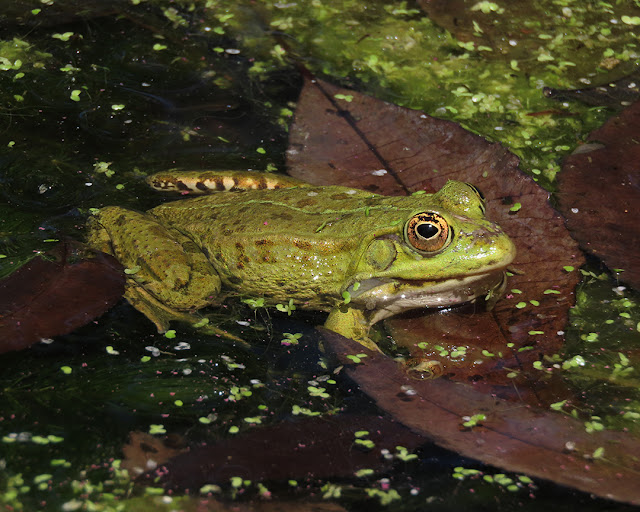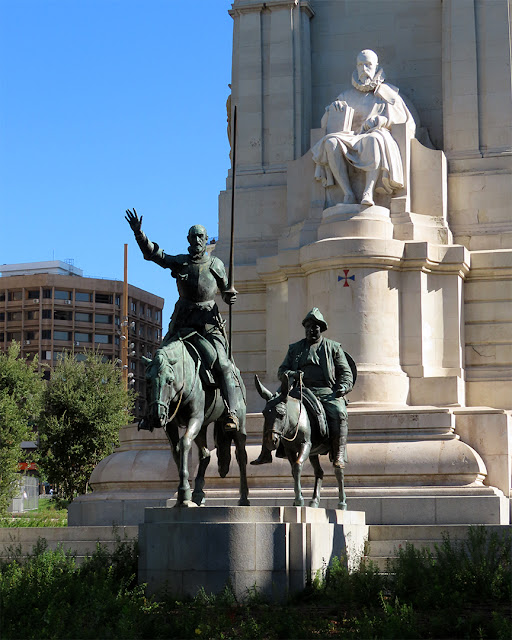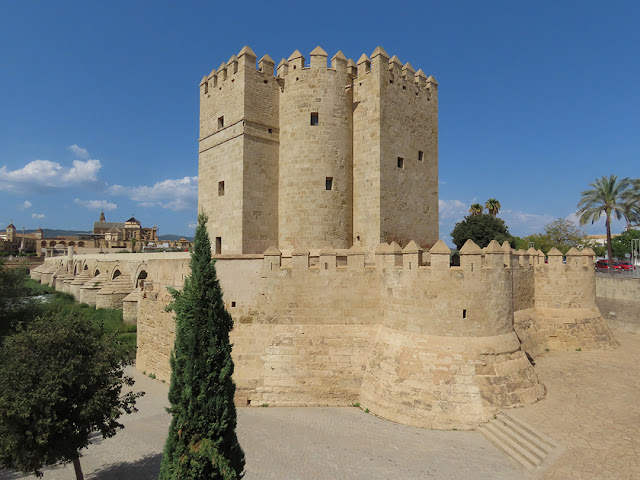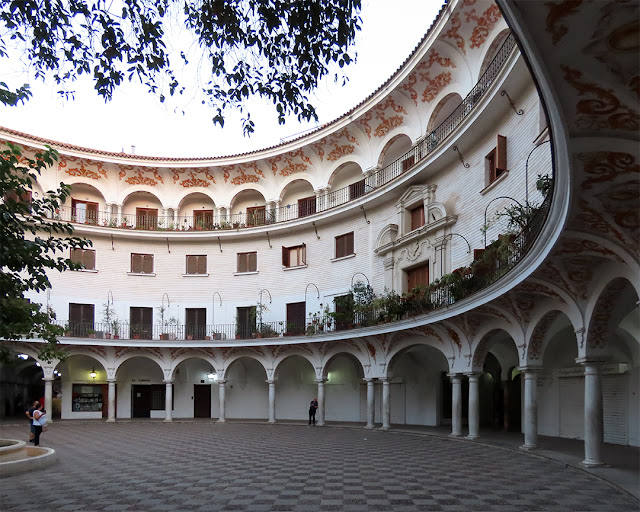Wednesday, November 30, 2022
Tuesday, November 29, 2022
Casa de los Gatos
Casa de los Gatos (House of Cats) by Alfonso Yuste Navarro, 2003
Carrer del Museu
Valencia, September 2022
“Cats are no strangers to urban agglomeration, especially in a warm climate, and the felines of Valencia are no exception. Feral cats roam the streets, looking for a place to rest their bones before being shooed away. The cat house offers them respite. At the foot of a blue wall on Carrer del Museu, the facade of a tiny house attracts the attention of passersby. The house is only a foot or two tall but it is designed in a classically Valencian style. It has a Spanish tiled roof, a little fountain, and a ‘garden’ to the side (actually just one potted plant). The house’s entrance is dark and does not appear to lead to the other side of the wall, but perhaps that’s just a ruse for human intruders. Legend has it that the old woman who previously owned the house behind the gate left it for the feral cats of Valencia to inhabit. Whether or not this is true and whether or not there are any cats behind the wall will have to remain a mystery—to the humans of Valencia at least.” (Cat House, Atlas Obscura)
Monday, November 28, 2022
Santo Sepolcro
Chiesa del Santo Sepolcro (Church of the Holy Sepulchre)
Piazza Santo Sepolcro
Pisa, April 2022
“The Church of the Santo Sepolcro (Chiesa del Santo Sepolcro) is a religious edifice in Pisa, Tuscany, Italy. Built in the early 12th century (it is known at least from 1113), it was designed by Diotisalvi, who also designed the Baptistery of Pisa Cathedral forty years later. It has an octagonal plan and, until the 16th century, it was surrounded by a portico. The central tambour, supported by eight ogival arches, is super-elevated and is surmounted by a conic cusp. The attribution to the Holy Sepulchre is a reference to the latter's relics which were carried in Pisa by archbishop Dagobert after his participation to the First Crusade. The structure resembles indeed the Dome of the Rock in Jerusalem, conquered by the crusaders in 1099. The portals have decorations with animals and lions' heads in marble. The interior, restored in 1720 in Baroque style, was destroyed in the 19th century. What remains include a bust-reliquary of St. Ubaldesca (15th century) with a pail which, according to the tradition, belonged to the saint; the tombstone of Marie Mancini, Mazarin's niece; and a 15th-century panel of the Madonna with Child. The unfinished small bell tower is in Pisane-Romanesque style, with rectangular plan.” (Santo Sepolcro, Wikipedia)
Sunday, November 27, 2022
Puerta del Sol
Puerta del Sol
Callejón San José
Toledo, September 2022
“Puerta del Sol is a city gate of Toledo, Spain, built in the late 14th century by the Knights Hospitaller. The medallion above the arch of the gate depicts the ordination of the Visigothic Ildephonsus, Toledo's patron saint. The name of the gate comes from the sun and the moon that were once painted on either side of this medallion. This gate was named because of its orientation to the east, where the sun always rises. The gate is no longer there, but the entrance is.” (Puerta del Sol, Wikipedia)
Saturday, November 26, 2022
Friday, November 25, 2022
Estación de Madrid Atocha
Estación de Madrid Atocha (Madrid Atocha railway station)
Plaza del Emperador Carlos V
Madrid, September 2022
“Madrid Atocha (Spanish: Estación de Madrid Atocha), also named Madrid Puerta de Atocha, is the first major railway station in Madrid. It is the largest station serving commuter trains (Cercanías), regional trains from the south and southeast, intercity trains from Navarre, Cádiz and Huelva (Andalusia) and La Rioja, and the AVE high speed trains from Girona, Tarragona and Barcelona (Catalonia), Huesca and Zaragoza (Aragon), Sevilla, Córdoba, Málaga and Granada (Andalusia), Valencia, Castellón and Alicante (Levante Region). These train services are run by Spain's national rail company, Renfe. As of 2019, this station has daily services to Marseille, France.” (Madrid Atocha railway station, Wikipedia)
Thursday, November 24, 2022
Palazzo Blu
Palazzo Blu
Lungarno Gambacorti
Pisa, April 2022
“Palazzo Blu is a center for temporary exhibitions and cultural activities located in 9 Lungarno Gambacorti, in the heart of the historic center of Pisa, Italy. This museum is managed by the Fondazione Palazzo Blu (a foundation funded by Fondazione Pisa), and is located in the Palazzo Giuli Rosselmini Gualandi (and Palazzo Casarosa), ancient palace restored by the Fondazione Pisa. Its name comes from the blue color uncovered during an architectural recent restoration, and attributable to the taste of Russian owners who acquired the Palazzo in the eighteenth century.” (Palazzo Blu, Wikipedia)
Wednesday, November 23, 2022
Cristo de los Faroles
Cristo de los Faroles (Christ of the Lanterns) by Juan Navarro León, 1794 Plaza de los Capuchinos
Córdoba, September 2022
“The Christ of Atonement and Mercy, popularly known as the Christ of the Lanterns (Spanish: Cristo de los Faroles), is a large Crucifix located at the Plaza de los Capuchinos in Cordoba, Spain. The sculpture was created in 1794 by the sculptor Juan Navarro León under a commission by the Capuchin friar Diego José de Cádiz. Its popular name comes from the eight lanterns set on iron mounts that illuminate it. The current appearance of the sculpture has developed with the construction of a fence in the 20th century and the replacement of the lanterns with darker ones in 1984.” (Christ of the Lanterns, Wikipedia)
Tuesday, November 22, 2022
Monday, November 21, 2022
Capilla del Carmen
Capilla del Carmen by Aníbal González Álvarez-Ossorio, 1928
Puente de Isabel II (Puente de Triana)
Seville, September 2022
“The Capilla de la Virgen del Carmen, better known as ‘La Capillita’ because of its small size, is located next to the Puente de Triana bridge in Seville, and is home to the patron saint of the sea and the Spanish Navy, and the protector of fishermen. The building is a symbol of the Triana neighbourhood. It took from 1924 to 1928 to build and it is the headquarters of the Hermandad de Gloria Nuestra Señora del Carmen brotherhood, although the history of its location begins long before it was built. The building consists of two small elements: a cylindrical chapel adorned by a dome that adjoins a bell tower via a rectangular body through which the building is accessed. There is an abundance of pottery in both the interior and the exterior of the chapel. Its shape resembles a ‘mechero’ (old-fashioned cigarette lighter) the name by which this unique chapel in Triana is popularly known.” (Capilla de la Virgen del Carmen, Andalucia.org)
Sunday, November 20, 2022
Saturday, November 19, 2022
Santa Catalina
Santa Catalina
Plaça de Santa Caterina
Valencia, September 2022
“Santa Catalina is a Gothic-style, Roman Catholic church located in the city of Valencia, Spain at the southern end of Plaza de la Reina. The church was built in the early 13th century at the site of a prior mosque. Most of the interior was rebuilt after a fire in 1548 acquiring the baroque style. It has a 16th-century portal of classicist style. The imposing bell tower, with a hexagonal base and five levels, once the site of a minaret, was rebuilt in a Baroque fashion between 1688 and 1705 using the designs of Juan Bautista Viñes. Today still presents the 13th-century gothic exterior. The church was restored in 1785.” (Santa Catalina, Wikipedia)
Friday, November 18, 2022
Thursday, November 17, 2022
Retablo
Retablo (Retable)
Catedral de Toledo (Toledo Cathedral)
Calle Cardenal Cisneros
Toledo, September 2022
“The retable of the Cathedral of Toledo is an extremely florid Gothic altarpiece; it is one of the last examples of this artistic style, which was disappearing as the Renaissance began to take hold in Spain. Commissioned by Cardinal Cisneros, the work was begun in 1497 and finished in 1504. Among the architects, painters and sculptors who collaborated in this collective masterwork were: Enrique Egas and Pedro Gumiel (design), Francisco de Amberes and Juan de Borgoña (estofado: the technique of finishing sculpture of wood with gilding and punched patterns, and polychromy), Rodrigo Alemán, Felipe Vigarny, Diego Copín de Holanda y Sebastián de Almonacid (religious images), and Joan Peti (carving and filigree). The retable rises to a great height above the altar; it includes an important statuary and a magnificent, delicate filigree of balusters, spires, small dossals, and chambranles, all done by Joan Peti. It consists of five continuous panels, the center panel being the widest; it is five storeys tall, and the lines of separation are stair-stepped. The themes of the central panel from bottom to top are: the figure of a seated Virgin and Child plated in silver on the predella, above this the tabernacle and a Gothic monstrance carved in wood, then a depiction of the Nativity, and above that, the Ascension. The whole culminates in a monumental scene of Christ's crucifixion at Calvary. Further themes of the life and passion of Jesus are represented on the other panels.” (Toledo Cathedral, Wikipedia)
Wednesday, November 16, 2022
Palazzo delle Conchiglie
Palazzo delle Conchiglie (Sea-shells Building)
Orto botanico (Botanical garden)
Via Ghini
Pisa, April 2022
“In 1563 the garden was relocated from its original riverside location (now the Medicean Arsenal) to one near the convent of Santa Marta, and in 1591 (under Joseph Goedenhuyze) again moved to its third and current location.” (Orto botanico di Pisa, Wikipedia)
Tuesday, November 15, 2022
Monumento a Miguel de Cervantes
Monument to Miguel de Cervantes, 1929
Plaza de España
Madrid, September 2022
“The Monument to Miguel de Cervantes is an instance of public art located in Madrid, Spain. Erected on the centre of the Plaza de España, it is dedicated to Miguel de Cervantes, widely regarded as the greatest writer in the Spanish language. The monument incorporates a stone monolith with several statues (including Cervantes') and a detached bronze sculptural group representing Don Quixote and Sancho Panza. In 1915, a year before the 300th anniversary of the writer's death, a public contest was announced in order to award the project. The announcement was met with concern among certain reviewers. The winning project was awarded to a dark horse proposal by Rafael Martínez Zapatero and Lorenzo Coullaut Valera that had been derided as overly literary, detail-oriented and anecdotal. The jury's decision was criticised via an open letter signed by at least 109 public figures, including, to name a few, Ramón del Valle Inclán, Alejandro Ferrant, Emilio Carrere, Daniel Zuloaga, Tomás Borrás and Ramón Gómez de la Serna.” (Monument to Miguel de Cervantes, Wikipedia)
Monday, November 14, 2022
Sunday, November 13, 2022
Torre de la Calahorra
Torre de la Calahorra (Calahorra Tower)
Puente Romano
Córdoba, September 2022
“The Calahorra tower (Spanish: Torre de la Calahorra) is a fortified gate in the historic centre of Córdoba, Spain. The edifice is of Islamic origin. It was first erected by the Almohad Caliphate to protect the nearby Roman Bridge on the Guadalquivir. The tower, standing on the left bank of the river, originally consisted of an arched gate between two. A third tower was added to the existing ones, in the shape of two cylinders connecting them. The tower was declared a national historical monument in 1931. The restoration of the tower, along with the Roman Bridge, Gate of the Bridge and surrounding area, was awarded the European Union Prize for Cultural Heritage / Europa Nostra Award in 2014.” (Calahorra Tower, Wikipedia)
Saturday, November 12, 2022
Botanical school
Scuola botanica (Botanical school)
Orto botanico (Botanical garden)
Via Ghini
Pisa, April 2022
“The Orto botanico di Pisa, also known as the Orto Botanico dell'Università di Pisa, is a botanical garden operated by the University of Pisa, and located at via Luca Ghini 5, Pisa, Italy. The garden was established in 1544 under Cosimo I de' Medici as the first university botanical garden in Europe, and entrusted to the famous botanist Luca Ghini of Imola.” (Orto botanico di Pisa, Wikipedia)
Friday, November 11, 2022
Plaza del Cabildo
Plaza del Cabildo
Calle Almirantazgo, El Arenal
Seville, September 2022
“The Plaza del Cabildo is a small semicircular square in the centre of Seville, located in the Arenal neighbourhood, next to the Cathedral of Seville. The square and the building itself were built on the site of the former college of San Miguel, owned by the Cabildo of the Cathedral, which is where the square got its current name of Plaza del Cabildo. But it was in the middle of the 20th century, around 1950, when the school was demolished. Today, only the façade facing the Avenida de la Constitución and some of the columns that were used in the square remain. The frescoed arcades on the ground floor are the work of the Sevillian painter José Palomar, and are set on marble columns. It is also a building designed by the architect Joaquín Barquín Barrón, in which Seville’s Moorish past is present, as the straight side of the square is occupied by a piece of the Almohad interior wall built in 1184, which came from the Alcazaba.” (Cabildo Square, OWAY Tours)
Thursday, November 10, 2022
Wednesday, November 9, 2022
Assut de l'Or Bridge
Assut de l'Or Bridge (Serreria Bridge) by Santiago Calatrava, 2008
Turìa Gardens
Valencia, September 2022
“The Assut de l'Or Bridge (Valencian: Pont de l'Assut de l'Or, Spanish: Puente de la Presa del Oro) is a white single-pylon cable-stayed bridge in the City of Arts and Sciences in Valencia, Spain, designed by Valencian architect and civil engineer Santiago Calatrava and completed in December 2008. The name l'Assut de l'Or is Valencian for the Dam of the Gold and refers to a dam that was located nearby, although locally it is referred to as El Jamonero (The Ham Holder) or Pont de l'Arpa, Spanish: Puente del Arpa (The Harp Bridge). Calatrava called it the Serreria Bridge. The bridge crosses the Turia Gardens in southeast Valencia, Spain near the east end of the City of Arts and Sciences complex. Its design is a variant of Santiago Calatrava's 1992 design of a cantilever spar cable-stayed bridge in Seville, Spain. In the Serreria bridge, the pylon is curved backward and back-stayed to concrete counterweights in the roadway. The aesthetic effect of the Serreria bridge arises in part from the curved pylon and the 29 parallel cables supporting the bridge deck, accented at night by spot lighting of the cables and the pylon. The bridge deck has two carriageways, three lanes each for cars and one additional lane for a tramway, and a carriageway for only pedestrian and cycle traffic along the middle spine of the deck by the cable stays.” (Assut de l'Or Bridge, Wikipedia)
Tuesday, November 8, 2022
Piazza dei Miracoli
Battistero di San Giovanni (Baptistery of St. John)
Cathedral of Santa Maria Assunta
Leaning Tower of Pisa
Piazza dei Miracoli (Piazza del Duomo)
Pisa, September 2020
“The Piazza dei Miracoli (Square of Miracles), formally known as Piazza del Duomo (Cathedral Square), is a walled 8.87-hectare area located in Pisa, Tuscany, Italy, recognized as an important centre of European medieval art and one of the finest architectural complexes in the world. Considered sacred by the Catholic Church, its owner, the square is dominated by four great religious edifices: the Pisa Cathedral, the Pisa Baptistry, the Campanile, and the Camposanto Monumentale (Monumental Cemetery). Partly paved and partly grassed, the Piazza dei Miracoli is also the site of the Ospedale Nuovo di Santo Spirito (New Hospital of the Holy Spirit), which houses the Sinopias Museum (Museo delle Sinopie) and the Cathedral Museum (Italian: Museo dell'Opera del Duomo). The name Piazza dei Miracoli was coined by the Italian writer and poet Gabriele d'Annunzio who, in his novel Forse che sì forse che no (1910), described the square as the ‘prato dei Miracoli’, or ‘meadow of miracles’. The square is sometimes called the Campo dei Miracoli ("Field of Miracles"). In 1987, the whole square was declared a UNESCO World Heritage Site.” (Piazza dei Miracoli, Wikipedia)
Monday, November 7, 2022
Toledo railway station
Railway station
Paseo Rosa
Toledo, September 2022
“The Toledo railway station is a railway station in Toledo, Spain, which was designed by architect Narciso Clavería y de Palacios in the Neo-Mudéjar style. The railway reached Toledo in 1858. The original station was of functional design and was opened on 12 June 1858 by Isabella II of Spain, accompanied by Francisco de Asís, Duke of Cádiz. The present station opened on 24 April 1919. It was designed to echo the historic architecture of the city. The central section is flanked by two side naves, one of which is adjacent to the clock tower, which imitates the style of Toledo church towers. The railway company responsible for the construction of Toledo station, the Compañía de los Ferrocarriles de Madrid a Zaragoza y Alicante, also built other stations in Neo-Mudejar style such as that of Aranjuez. The station has been declared a Property of Cultural Interest and classified as a monument. It was restored in the twenty-first century in connection with the inauguration of the Madrid–Toledo high-speed rail line in 2005.[5] The old line along the Tagus valley in the direction of Aranjuez has been dismantled, and Toledo no longer has a conventional line.” (Toledo railway station, Wikipedia)
Sunday, November 6, 2022
Saturday, November 5, 2022
Pasarela de Arganzuela
Pasarela de Arganzuela (Arganzuela Footbridge) by Dominique Perrault, 2011
Madrid Río park
Madrid, September 2022
“The Arganzuela Footbridge is a pedestrian bridge in Madrid, Spain. It partially occupies the land released by the burying of the M-30. Designed by Dominique Perrault, it cost about €13.6M. Building works started in February 2010. The footbridge actually consists of two separate metal cones, one passing over the Madrid Río park while the other crosses over the Manzanares, nearly meeting at an elevated middle point serving as lookout of the Madrid Río park. The combined structure is 278 m long. Perrault employs plate rolling for the curved steel plates along the bridge span. It was opened on 24 March 2011, although initially only for diurnal usage.” (Arganzuela Footbridge, Wikipedia)
Friday, November 4, 2022
San Pietro in Vinculis
San Pietro in Vinculis
Via Cavour
Pisa, April 2022
“San Pietro in Vinculis is a Romanesque-style, Roman Catholic church in Pisa, region of Tuscany, Italy. History It was built by the Augustinians in 1072-1118 over a pre-existing edifice. The rectory was added a few years later. The structure follows the Pisane Romanesque style established by Buscheto. It has a nave and two aisles with apses. The façade is articulated by pilaster strips, blind arches, oculi (small circular windows), lozenges and mullioned windows. In the interior the intarsia pavement lies over a crypt with groin vaults and Roman capitals, perhaps the relic of an ancient market loggia later turned into a Christian temple. It houses a Roman sarcophagus, remains of frescoes and a Crucifix on panel from the 13th century. In the rectory are frescoes from the 13th and 15th centuries and 18th century stuccoes. The bell tower was in origin a civil tower (late 11th-early 12th century). For years, the church kept a famous manuscript containing a digest of the Corpus Juris Civilis of Emperor Justinian I of the Eastern Roman Empire. The document had fallen into Pisan hands after the sack of Amalfi in 1137. After Pisa fell in 1406, the Florence the document was transferred to the latter city.” (San Pietro in Vinculis, Wikipedia)
Thursday, November 3, 2022
Dome of the Mihrab
Dome of the Mihrab
Mezquita-Catedral de Córdoba
(Mosque–Cathedral of Córdoba)
Calle Cardenal Herrero
Córdoba, September 2022
“Above the mihrab, is an equally dazzling dome. The Dome of the Cordova Mosque is built of crisscrossing ribs that create pointed arches all lavishly covered with gold mosaic in a radial pattern. This astonishing building technique anticipates later Gothic rib vaulting, though on a more modest scale. As the mihrab is flanked by two chambers, the dome of the Mosque is also flanked by two other domes.” (Mihrab of Cordoba Mosque, Madain Project)
Wednesday, November 2, 2022
Tuesday, November 1, 2022
Torre Sevilla
Torre Sevilla (Sevilla Tower) by César Pelli, 2015
Calle Gonzalo Jimenez de Quesada
Seville, September 2022
“The tower is located in La Cartuja, the former zone of the Universal Exposition that took place in Seville between April and October 1992. It is located next to the river in an area being redeveloped since the early 2000s. The tower is flanked by two four story podium buildings also designed by César Pelli. The curved edges of the podium buildings define a plaza that opens on the north and south and narrows at the center, creating a pedestrian-scaled commercial street. The tower notably hosts a 5-star hotel, Eurostars Torre Sevilla, along with various offices.” (Sevilla Tower, Wikipedia)
Subscribe to:
Posts (Atom)






























